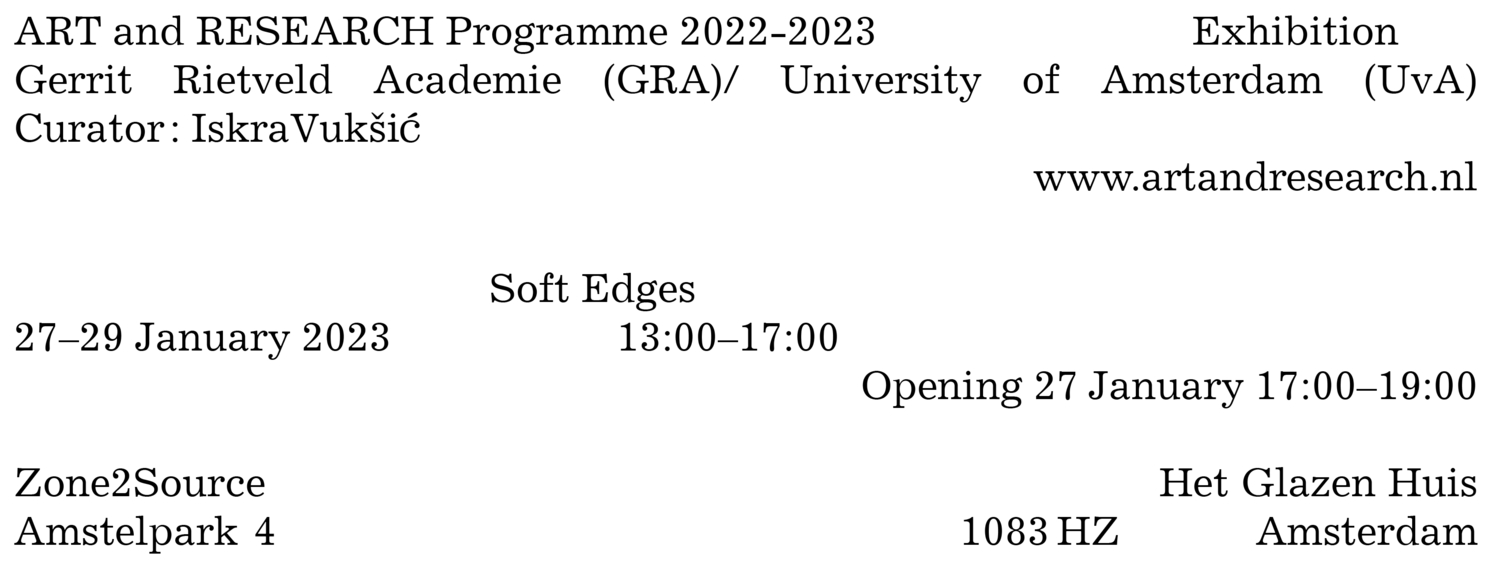
ART and RESEARCH Programme 2022-2023
Gerrit Rietveld Academie/ University of Amsterdam
EXHIBITION
SOFT EDGES
27–29 January 2023
Opening 27 January 17:00 – 19:00
PARTICIPANTS
Chaemin Hwang - Graphic Design - Gerrit Rietveld Academie
Eleri Lee - Design Lab - Gerrit Rietveld Academie
Adriane Bastiaens - Fine Arts - Gerrit Rietveld Academie
Rosa Shepherd - Architectural Design - Gerrit Rietveld Academie
Karl Götter - Fine Arts - Gerrit Rietveld Academie
Sara Pezzolesi - DOGTime - Gerrit Rietveld Academie
Maja Wachowska - Design Lab - Gerrit Rietveld Academie
Maartje Stapel - Fine Arts - Gerrit Rietveld Academie
Stella Kummer - Philosophy - University of Amsterdam
Alexis Dickinson - Sociology - University of Amsterdam
Isaac Deen - Physics and Astronomy - University of Amsterdam / Vrije Universiteit Amsterdam
Cameron Howie - Political Science - University of Amsterdam
Anna Fleuri - Literary and Cultural Analysis - University of Amsterdam
Emma Boonstra - Interdisciplinary Social Sciences - University of Amsterdam
Vera Horjus - Physics and Astronomy - University of Amsterdam / Vrije Universiteit Amsterdam
Sophia Jesserun - Cultural Studies - University of Amsterdam
Lina Mittendorff - Cultural Anthropology and Development Sociology - University of Amsterdam
CURATOR
Iskra Vukšić
LOCATION
Zone2Source
Het Glazen Huis
Amstelpark 4
1083 HZ Amsterdam
DESIGN
Anaëlle Enjalbert
ABOUT THE PROGRAMME
The ART and RESEARCH Programme consists of a collaboration between the Gerrit Rietveld Academie and the University of Amsterdam. Initially developed in 2006 and already in its 12th edition, it aims to combine the most productive aspects and activities of both institutions. To this end, the programme provides art students the opportunity to engage with theory on a deeper level than is offered by the Gerrit Rietveld Academie’s regular courses, while involving university students in creative processes generally absent from the scope of the curricula at the University of Amsterdam.
Departing from the idea that certain overlaps occur between the practices of science and art, the programme stimulates students to share and exchange different perspectives and methodologies, as well as challenge methodological traditions, so as to create renewed modes of research, while learning about each other’s fields of study in the process. ART and RESEARCH brings an extremely wide range of disciplines together, with this edition’s participants coming from the Gerrit Rietveld Academie’s departments of Architectural Design, Graphic Design, Fine Arts, Design Lab, and DOGTime; and the University of Amsterdam’s departments of Philosophy, Literary and Cultural Analysis, Sociology, Cultural Studies, Cultural Anthropology and Development Sociology, Political Science, Interdisciplinary Social Sciences, and Physics and Astronomy (a joint degree offered by the UvA and Vrije Universiteit).
The programme consists of a group of twenty selected students working on a joint project for a period of twelve months. The process begins by mapping research interests and methodologies in a group-wide brainstorming session, to make shared themes and possible research projects come to the surface. Based on this session, the students form small multi-disciplinary groups in which they collaborate intensively for the rest of the year. The research process involves engaging with theory, working with materials, collaborative writing, and presentations to invited guest critics, culminating in a publication and group exhibition at the end of the programme. As part of this process, the students also attend a four-day training retreat outside of Amsterdam, this year at Wongema. Here they engage in various exercises that bring fresh perspectives to their chosen research topics.
For this 12th edition, the students began by focusing on four urgent, yet wide-ranging themes: memory, disenchantment, communication, and the intersection of embodiment and borders. These topics have been refined and elaborated over the course of the year, in dialogue with the tutors and with oneanother. The work presented in this publication reflects both the challenges and opportunities that may emerge through sustained collaboration across disciplines.
The above-mentioned projects were realized alongside the student’s regular schedule. Although they are guided by tutors, guest lecturers, and other professionals, the students actively contribute to the development of the programme’s content as it progresses. Crucially, most of the organizational work involved in the production of the presentation and publication also lies in their hands, which further contributes to the uniqueness of the programme.